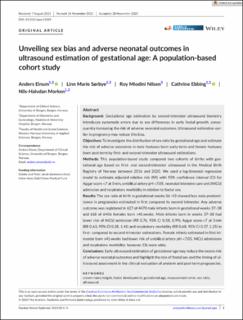| dc.contributor.author | Einum, Anders | |
| dc.contributor.author | Sørbye, Linn Marie | |
| dc.contributor.author | Nilsen, Roy Miodini | |
| dc.contributor.author | Ebbing, Cathrine | |
| dc.contributor.author | Morken, Nils-Halvdan | |
| dc.date.accessioned | 2024-04-17T09:15:40Z | |
| dc.date.available | 2024-04-17T09:15:40Z | |
| dc.date.created | 2024-01-03T17:06:41Z | |
| dc.date.issued | 2024 | |
| dc.identifier.issn | 0269-5022 | |
| dc.identifier.uri | https://hdl.handle.net/11250/3126959 | |
| dc.description.abstract | Background
Gestational age estimation by second-trimester ultrasound biometry introduces systematic errors due to sex differences in early foetal growth, consequently increasing the risk of adverse neonatal outcomes. Ultrasound estimation earlier in pregnancy may reduce this bias.
Objectives
To investigate the distribution of sex ratio by gestational age and estimate the risk of adverse outcomes in male foetuses born early-term and female foetuses born post-term by first- and second-trimester ultrasound estimations.
Methods
This population-based study compared two cohorts of births with gestational age based on first- and second-trimester ultrasound in the Medical Birth Registry of Norway between 2016 and 2020. We used a log-binomial regression model to estimate adjusted relative risk (RR) with 95% confidence interval (CI) for Apgar score <7 at 5 min, umbilical artery pH <7.05, neonatal intensive care unit (NICU) admission and respiratory morbidity in relation to foetal sex.
Results
The sex ratio at birth in gestational weeks 36–43 showed less male predominance in pregnancies estimated in first compared to second trimester. Any adverse outcome was registered in 627 of 4470 male infants born in gestational weeks 37–38 and 618 of 6406 females born ≥41 weeks. Male infants born in weeks 37–38 had lower risk of NICU admission (RR 0.76, 95% CI 0.58, 0.99), Apgar score <7 at 5 min (RR 0.63, 95% CI 0.28, 1.41) and respiratory morbidity (RR 0.68, 95% CI 0.37, 1.25) in first- compared to second-trimester estimations. Female infants estimated in first trimester born ≥41 weeks had lower risk of umbilical artery pH <7.05, NICU admissions and respiratory morbidity; however, CIs were wide.
Conclusions
Early ultrasound estimation of gestational age may reduce the excess risk of adverse neonatal outcomes and highlight the role of foetal sex and the timing of ultrasound assessment in the clinical evaluation of preterm and post-term pregnancies. | en_US |
| dc.language.iso | eng | en_US |
| dc.publisher | Wiley | en_US |
| dc.rights | Attribution-NonCommercial-NoDerivatives 4.0 Internasjonal | * |
| dc.rights.uri | http://creativecommons.org/licenses/by-nc-nd/4.0/deed.no | * |
| dc.title | Unveiling sex bias and adverse neonatal outcomes in ultrasound estimation of gestational age: A population-based cohort study | en_US |
| dc.type | Journal article | en_US |
| dc.type | Peer reviewed | en_US |
| dc.description.version | publishedVersion | en_US |
| dc.rights.holder | Copyright 2023 The Author(s) | en_US |
| cristin.ispublished | true | |
| cristin.fulltext | original | |
| cristin.qualitycode | 1 | |
| dc.identifier.doi | 10.1111/ppe.13029 | |
| dc.identifier.cristin | 2220199 | |
| dc.source.journal | Paediatric and Perinatal Epidemiology | en_US |
| dc.source.pagenumber | 34-42 | en_US |
| dc.identifier.citation | Paediatric and Perinatal Epidemiology. 2024, 38 (1), 34-42. | en_US |
| dc.source.volume | 38 | en_US |
| dc.source.issue | 1 | en_US |

